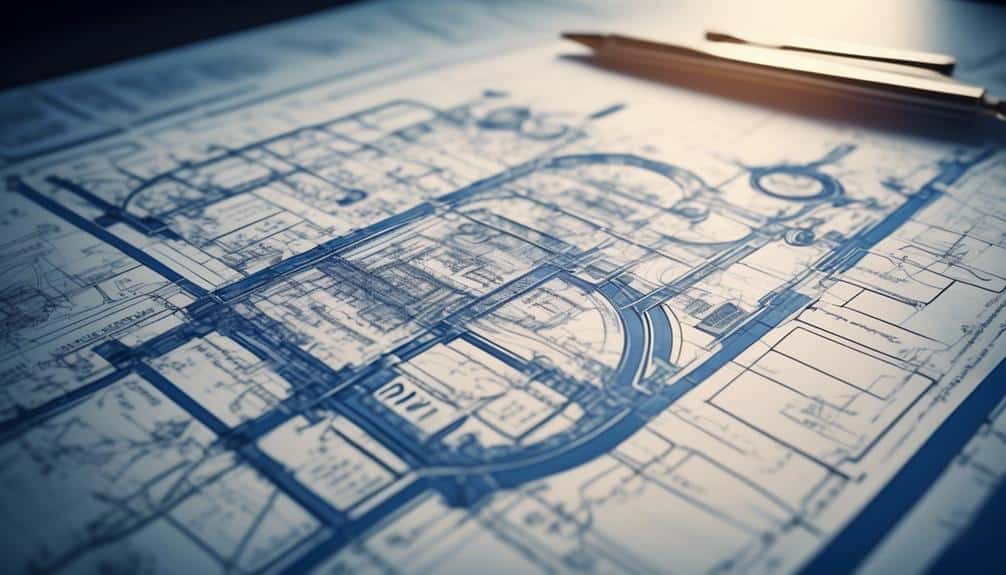The Blueprint of Success: Mastering the Art of Content Outlining
When it comes to navigating the path towards achieving your writing objectives, mastering the art of content outlining can be a valuable asset in your toolbox. By strategically structuring your ideas and crafting a blueprint for your content, you can pave the way for a smoother and more efficient writing process.
But what exactly does it take to create an effective outline that not only outlines your content but also sets you up for success in your writing endeavors?
Key Takeaways
- Content outlining is crucial for effective communication and structured organization.
- Utilizing visual cues and transitions enhances the coherence and impact of writing.
- Organizing ideas through categorization and brainstorming leads to a more streamlined workflow.
- Implementing tools like outlining apps and mind mapping software can optimize the outlining process for increased productivity.
Importance of Content Outlining

Mastering content outlining is crucial for effective communication and structured organization in any written work. By creating a clear outline, you can ensure increased focus on key points and better communication of your ideas to your audience. The process of outlining forces you to think strategically about the flow of your content, helping you to organize your thoughts in a logical manner.
When you outline your content, you're essentially creating a roadmap that guides your writing process. This roadmap not only keeps you on track but also helps you stay organized and ensures that your ideas are presented in a coherent and structured way. As a result, your writing becomes more concise and impactful, making it easier for your readers to follow along and understand your message.
In essence, content outlining acts as a foundation for your writing, providing a solid structure that supports the overall coherence and effectiveness of your work. So, embrace the power of outlining to enhance your communication skills and take your writing to the next level.
Benefits of Structured Outlines
When creating structured outlines, you gain improved organization efficiency as it helps you clearly map out your content.
This method provides a clear direction for your writing, ensuring your ideas flow logically and cohesively.
Improved Organization Efficiency
Implementing structured outlines significantly enhances organizational efficiency by streamlining information, fostering clarity, and facilitating seamless workflow. By incorporating these time-saving techniques and improved focus into your outlining process, you can experience a boost in productivity and effectiveness.
Here are five key benefits of utilizing structured outlines:
- Enhanced Creativity: Clear outlines provide a framework for creative ideas to flourish.
- Streamlined Workflow: Sequentially organized content allows for a smoother workflow.
- Improved Time Management: Prioritized outlines help in managing tasks efficiently.
- Increased Collaboration: Shared outlines promote teamwork and idea sharing.
- Better Decision Making: Structured information aids in making informed decisions quickly.
Embrace structured outlines to revolutionize your organization's efficiency and unlock your team's full potential.
Clear Content Direction
To achieve clear content direction through structured outlines, focus on outlining your key points concisely and strategically. Clear content structure is essential for guiding your readers through your ideas seamlessly.
Utilize outlining techniques such as bullet points, headings, and subheadings to create a roadmap for your content. By organizing your thoughts in a logical manner, you provide a clear path for your audience to follow, enhancing their understanding and retention of the material.
Structured outlines also help you maintain focus and stay on track while writing, preventing you from going off on tangents. When your content has a clear direction, it becomes more engaging and impactful, resonating with your audience and achieving the desired results.
Key Elements of an Effective Outline

To create a truly effective outline, you need to focus on three key elements:
Structure Essentials, Content Organization Tips, and Outline Efficiency Hacks.
These elements are crucial for ensuring that your outline is well-organized, easy to follow, and maximally efficient in conveying your message.
Structure Essentials
Outline:
- Clear Hierarchy:
- Ensure a logical flow from main points to subpoints.
- Concise Phrasing:
- Use brief but descriptive phrases to convey ideas.
- Transitions:
- Include smooth transitions to connect different sections seamlessly.
- Visual Cues:
- Utilize formatting like bold, italics, or bullet points for visual appeal.
- Flexibility:
- Leave room for adjustments and additions to accommodate evolving ideas.
Content Organization Tips
When organizing your content effectively in an outline, prioritize clarity and coherence through a meticulous arrangement of key elements. Content planning and outlining techniques play a crucial role in crafting a well-structured piece. To aid in your content organization journey, consider the following tips:
| Prioritize Main Ideas | Use Parallel Structure | Include Supporting Details |
|---|---|---|
| Identify central themes or arguments | Maintain consistency in formatting | Provide evidence or examples |
| Create Subheadings | Utilize Bullet Points | Review and Revise |
| Break down content into sections | List key points succinctly | Fine-tune for cohesion and flow |
Outline Efficiency Hacks
For optimal outlining efficiency, focus on incorporating key elements that enhance the structure and coherence of your content plan. When it comes to efficiency hacks and time management strategies for outlining, consider the following:
- Utilize Templates: Start with pre-designed templates tailored to your content type.
- Color Code Sections: Assign different colors to various sections for quick visual reference.
- Mind Mapping: Use tools like mind maps to visually organize and connect ideas.
- Set Time Limits: Allocate specific time slots for each outlining phase to stay focused.
- Collaborate Virtually: Leverage online platforms for real-time collaboration and feedback.
Implementing these strategies will streamline your outlining process and boost productivity effectively.
Strategies for Organizing Ideas

To effectively organize your ideas, begin by categorizing them based on their relevance and relationship to one another. Utilize brainstorming techniques and creative visualization to generate a diverse range of concepts. Through mind mapping, visually connect these ideas to uncover patterns and associations. This technique aids in structuring your thoughts cohesively, leading to a more organized outline.
When implementing topic grouping, consider clustering related ideas together to enhance the flow and coherence of your content. By grouping similar concepts, you create a logical structure that guides your audience seamlessly through your work. This strategy not only improves the clarity of your outline but also helps in presenting information in a compelling and engaging manner.
Tools for Outlining Success
After categorizing and grouping your ideas effectively, the next step towards mastering content outlining involves utilizing specialized tools tailored for enhancing your outlining process. These outlining tools and techniques can significantly boost your productivity and creativity.
Here are five essential tools to incorporate into your outlining arsenal:
- Mind Mapping Software: Use tools like MindMeister or XMind to visually organize and connect your ideas in a nonlinear way.
- Outlining Apps: Consider using apps like Workflowy or Dynalist for creating detailed outlines that can be easily rearranged and expanded.
- Collaboration Platforms: Utilize platforms such as Google Docs or Notion to collaborate with others in real-time on outlining projects.
- Graphic Organizers: Experiment with tools like Lucidchart or Canva to create structured visual representations of your outlines.
- Voice-to-Text Tools: Explore options like Dragon NaturallySpeaking or Otter.ai for hands-free outlining by dictating your ideas.
Incorporating these outlining tools into your workflow can revolutionize the way you approach structuring and organizing your content.
Tips for Streamlining Your Process

Optimize your outlining workflow by implementing efficient methods to streamline your process. Time management plays a crucial role in content outlining success. Begin by setting clear objectives for each outlining session. Allocate specific time blocks for brainstorming, organizing ideas, and structuring your content. Utilize tools like timers or productivity apps to stay on track and maintain focus.
Workflow optimization is key to maximizing productivity. Create a standardized outline template that suits your content needs. This template should include sections for introductions, main points, supporting details, and conclusions. By having a consistent framework, you can streamline the outlining process and ensure all essential elements are included.
Additionally, consider utilizing collaborative tools for team projects. Platforms like Google Docs or Trello allow for real-time collaboration and seamless communication, enhancing efficiency and workflow coordination.
Regularly review and adjust your outlining process to identify areas for improvement. Experiment with different techniques, such as mind mapping or reverse outlining, to find what works best for you. By continuously refining your approach, you can enhance productivity and achieve optimal results in your content creation endeavors.
Enhancing Message Clarity
Enhancing message clarity within your content requires a strategic approach that focuses on precise communication and detailed organization. To ensure improved communication and concise messaging, consider the following:
- Define Clear Objectives: Clearly outline the purpose and main points you want to convey in your content.
- Use Visual Aids: Incorporate visual elements like charts or infographics to enhance understanding.
- Utilize Formatting Techniques: Use headings, bullet points, and white space effectively to break down information into digestible chunks.
- Eliminate Jargon: Avoid technical language or industry-specific terms that may confuse your audience.
- Seek Feedback: Test your content on a sample audience to ensure the message is clear and resonates with them.
Increasing Writing Productivity

Boost your writing productivity by implementing efficient time management techniques and focused goal setting strategies. To increase focus and streamline your writing process, start by creating a detailed schedule outlining specific blocks of time dedicated to writing. Set clear goals for each writing session, breaking them down into smaller tasks to make them more manageable. Prioritize your tasks based on deadlines and importance to ensure you stay on track.
Utilize tools such as time tracking apps or productivity apps to monitor your writing progress and identify any areas where you may be losing time. By understanding how you spend your time, you can make adjustments to eliminate distractions and optimize your workflow. Consider using techniques like the Pomodoro method to work in focused bursts with short breaks in between to maintain productivity.
Additionally, establish a designated writing space that's free from distractions and conducive to creativity. This space should be organized and comfortable, allowing you to fully immerse yourself in your writing tasks. By implementing these time management strategies and increasing your focus, you can enhance your writing productivity and achieve your goals more efficiently.
Achieving Writing Goals Efficiently
To efficiently achieve your writing goals, it's essential to maintain the focus and organization cultivated through effective time management techniques. Utilizing writing strategies can help you stay on track and reach your goals more efficiently. Here are some key tips to enhance your writing productivity:
- Set Clear Objectives: Define specific writing goals to focus your efforts effectively.
- Create a Detailed Timeline: Break down your writing tasks into manageable sections with deadlines.
- Utilize Productivity Tools: Explore software and apps that can aid in organizing your writing process.
- Implement Pomodoro Technique: Work in focused intervals with short breaks to maintain productivity.
- Seek Feedback: Regularly review your progress and seek input from peers or mentors to improve your writing.
Frequently Asked Questions
How Can Content Outlining Help With Overcoming Writer's Block?
When facing writer's block, content outlining provides a structured approach to organize thoughts and ideas. Utilize brainstorming strategies and creative prompts to jumpstart your writing process. Problem-solving techniques and productivity hacks can also enhance your efficiency.
Can Content Outlining Be Used for Other Types of Creative Projects Besides Writing?
When tackling graphic design or video production, content outlining is your secret weapon. It provides structure, clarity, and a roadmap for your creative vision. Transform your projects by harnessing the power of organized planning.
Are There Specific Techniques for Integrating Visual Elements Into a Content Outline?
To integrate visual elements into your content outline effectively, engage in visual brainstorming sessions. Infuse creativity by using sketches, colors, and symbols to enhance your storytelling. This technique will elevate the impact of your outline.
How Can Content Outlining Be Adapted for Collaborative Writing Projects?
When tackling collaborative writing projects, prioritize team collaboration and brainstorming sessions to gather diverse ideas. Implement version control for seamless revisions. This strategic approach fosters innovation and ensures a cohesive final product that reflects collective expertise.
Can Content Outlining Be Beneficial for Non-Linear Writing Styles or Projects With Multiple Storylines?
For non-linear storytelling and managing multiple narratives, content outlining offers invaluable organization and structure. It enables a clear roadmap for weaving together complex storylines, ensuring cohesion and coherence in your projects.
Conclusion
Congratulations on mastering the art of content outlining! By utilizing structured outlines, organizing ideas effectively, and streamlining your process, you have unlocked the blueprint for success in your writing endeavors.
With increased message clarity, boosted writing productivity, and efficient goal achievement, you're well-equipped to tackle any writing task that comes your way.
Keep honing your outlining skills and watch your content creation soar to new heights!








